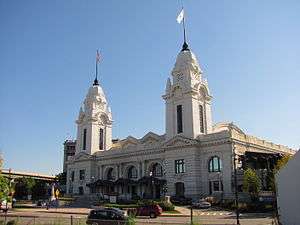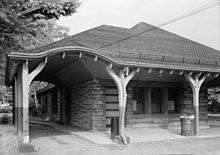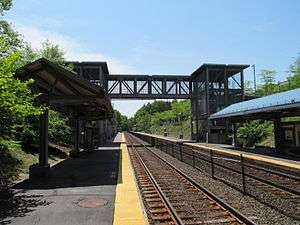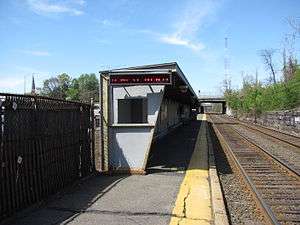Framingham/Worcester Line
The Framingham/Worcester Line of the MBTA Commuter Rail system runs west from Boston, Massachusetts to Worcester, Massachusetts through the MetroWest region, serving 17 station stops in Boston, Newton, Wellesley, Natick, Framingham, Ashland, Southborough, Westborough, Grafton, and Worcester. The third-longest and second-busiest line on the system, the Framingham/Worcester Line is plagued by poor track conditions, interference from freight trains, and a number of non-handicapped-accessible stations. Service on the line is a mix of local and express trains serving Worcester plus short-turn Framingham locals.
| Framingham/Worcester Line | |||||||||||||||||||||||||||||||||||||||||||||||||||||||||||||||||||||||||||||||||||||||||||||||||||||||||||||||||||||||||||||||||||||||||||||||||||||||||||||||||||||||||||||||||||||||||||||||||||||||||||||||||||||||||||||||||||||||||||||||||||||||||||||||||||||||||||||||||||||||||||||||||||||||||||||||||||||||||||||||||||||||||||||||||||||||||||||||||||||||||
|---|---|---|---|---|---|---|---|---|---|---|---|---|---|---|---|---|---|---|---|---|---|---|---|---|---|---|---|---|---|---|---|---|---|---|---|---|---|---|---|---|---|---|---|---|---|---|---|---|---|---|---|---|---|---|---|---|---|---|---|---|---|---|---|---|---|---|---|---|---|---|---|---|---|---|---|---|---|---|---|---|---|---|---|---|---|---|---|---|---|---|---|---|---|---|---|---|---|---|---|---|---|---|---|---|---|---|---|---|---|---|---|---|---|---|---|---|---|---|---|---|---|---|---|---|---|---|---|---|---|---|---|---|---|---|---|---|---|---|---|---|---|---|---|---|---|---|---|---|---|---|---|---|---|---|---|---|---|---|---|---|---|---|---|---|---|---|---|---|---|---|---|---|---|---|---|---|---|---|---|---|---|---|---|---|---|---|---|---|---|---|---|---|---|---|---|---|---|---|---|---|---|---|---|---|---|---|---|---|---|---|---|---|---|---|---|---|---|---|---|---|---|---|---|---|---|---|---|---|---|---|---|---|---|---|---|---|---|---|---|---|---|---|---|---|---|---|---|---|---|---|---|---|---|---|---|---|---|---|---|---|---|---|---|---|---|---|---|---|---|---|---|---|---|---|---|---|---|---|---|---|---|---|---|---|---|---|---|---|---|---|---|---|---|---|---|---|---|---|---|---|---|---|---|---|---|---|---|---|---|---|---|---|---|---|---|---|---|---|---|---|---|---|---|---|---|---|---|---|---|---|---|---|---|---|---|---|---|---|---|---|---|---|---|---|---|---|---|---|---|---|---|---|---|---|---|---|---|---|---|---|---|
 Front facade of Worcester Union Station | |||||||||||||||||||||||||||||||||||||||||||||||||||||||||||||||||||||||||||||||||||||||||||||||||||||||||||||||||||||||||||||||||||||||||||||||||||||||||||||||||||||||||||||||||||||||||||||||||||||||||||||||||||||||||||||||||||||||||||||||||||||||||||||||||||||||||||||||||||||||||||||||||||||||||||||||||||||||||||||||||||||||||||||||||||||||||||||||||||||||||
| Overview | |||||||||||||||||||||||||||||||||||||||||||||||||||||||||||||||||||||||||||||||||||||||||||||||||||||||||||||||||||||||||||||||||||||||||||||||||||||||||||||||||||||||||||||||||||||||||||||||||||||||||||||||||||||||||||||||||||||||||||||||||||||||||||||||||||||||||||||||||||||||||||||||||||||||||||||||||||||||||||||||||||||||||||||||||||||||||||||||||||||||||
| Type | Commuter rail line | ||||||||||||||||||||||||||||||||||||||||||||||||||||||||||||||||||||||||||||||||||||||||||||||||||||||||||||||||||||||||||||||||||||||||||||||||||||||||||||||||||||||||||||||||||||||||||||||||||||||||||||||||||||||||||||||||||||||||||||||||||||||||||||||||||||||||||||||||||||||||||||||||||||||||||||||||||||||||||||||||||||||||||||||||||||||||||||||||||||||||
| System | Massachusetts Bay Transportation Authority | ||||||||||||||||||||||||||||||||||||||||||||||||||||||||||||||||||||||||||||||||||||||||||||||||||||||||||||||||||||||||||||||||||||||||||||||||||||||||||||||||||||||||||||||||||||||||||||||||||||||||||||||||||||||||||||||||||||||||||||||||||||||||||||||||||||||||||||||||||||||||||||||||||||||||||||||||||||||||||||||||||||||||||||||||||||||||||||||||||||||||
| Status | Operating | ||||||||||||||||||||||||||||||||||||||||||||||||||||||||||||||||||||||||||||||||||||||||||||||||||||||||||||||||||||||||||||||||||||||||||||||||||||||||||||||||||||||||||||||||||||||||||||||||||||||||||||||||||||||||||||||||||||||||||||||||||||||||||||||||||||||||||||||||||||||||||||||||||||||||||||||||||||||||||||||||||||||||||||||||||||||||||||||||||||||||
| Locale | Central Massachusetts | ||||||||||||||||||||||||||||||||||||||||||||||||||||||||||||||||||||||||||||||||||||||||||||||||||||||||||||||||||||||||||||||||||||||||||||||||||||||||||||||||||||||||||||||||||||||||||||||||||||||||||||||||||||||||||||||||||||||||||||||||||||||||||||||||||||||||||||||||||||||||||||||||||||||||||||||||||||||||||||||||||||||||||||||||||||||||||||||||||||||||
| Termini | Boston South Station Worcester Union Station | ||||||||||||||||||||||||||||||||||||||||||||||||||||||||||||||||||||||||||||||||||||||||||||||||||||||||||||||||||||||||||||||||||||||||||||||||||||||||||||||||||||||||||||||||||||||||||||||||||||||||||||||||||||||||||||||||||||||||||||||||||||||||||||||||||||||||||||||||||||||||||||||||||||||||||||||||||||||||||||||||||||||||||||||||||||||||||||||||||||||||
| Stations | 17 | ||||||||||||||||||||||||||||||||||||||||||||||||||||||||||||||||||||||||||||||||||||||||||||||||||||||||||||||||||||||||||||||||||||||||||||||||||||||||||||||||||||||||||||||||||||||||||||||||||||||||||||||||||||||||||||||||||||||||||||||||||||||||||||||||||||||||||||||||||||||||||||||||||||||||||||||||||||||||||||||||||||||||||||||||||||||||||||||||||||||||
| Daily ridership | 18,636 (2018)[1] | ||||||||||||||||||||||||||||||||||||||||||||||||||||||||||||||||||||||||||||||||||||||||||||||||||||||||||||||||||||||||||||||||||||||||||||||||||||||||||||||||||||||||||||||||||||||||||||||||||||||||||||||||||||||||||||||||||||||||||||||||||||||||||||||||||||||||||||||||||||||||||||||||||||||||||||||||||||||||||||||||||||||||||||||||||||||||||||||||||||||||
| Operation | |||||||||||||||||||||||||||||||||||||||||||||||||||||||||||||||||||||||||||||||||||||||||||||||||||||||||||||||||||||||||||||||||||||||||||||||||||||||||||||||||||||||||||||||||||||||||||||||||||||||||||||||||||||||||||||||||||||||||||||||||||||||||||||||||||||||||||||||||||||||||||||||||||||||||||||||||||||||||||||||||||||||||||||||||||||||||||||||||||||||||
| Opened | 1834–1835 (Boston and Worcester Railroad) | ||||||||||||||||||||||||||||||||||||||||||||||||||||||||||||||||||||||||||||||||||||||||||||||||||||||||||||||||||||||||||||||||||||||||||||||||||||||||||||||||||||||||||||||||||||||||||||||||||||||||||||||||||||||||||||||||||||||||||||||||||||||||||||||||||||||||||||||||||||||||||||||||||||||||||||||||||||||||||||||||||||||||||||||||||||||||||||||||||||||||
| Owner | MassDOT (Back Bay to Riverside) MBTA (Riverside to Framingham) MassDOT (Framingham to Worcester)[2] | ||||||||||||||||||||||||||||||||||||||||||||||||||||||||||||||||||||||||||||||||||||||||||||||||||||||||||||||||||||||||||||||||||||||||||||||||||||||||||||||||||||||||||||||||||||||||||||||||||||||||||||||||||||||||||||||||||||||||||||||||||||||||||||||||||||||||||||||||||||||||||||||||||||||||||||||||||||||||||||||||||||||||||||||||||||||||||||||||||||||||
| Operator(s) | Keolis North America | ||||||||||||||||||||||||||||||||||||||||||||||||||||||||||||||||||||||||||||||||||||||||||||||||||||||||||||||||||||||||||||||||||||||||||||||||||||||||||||||||||||||||||||||||||||||||||||||||||||||||||||||||||||||||||||||||||||||||||||||||||||||||||||||||||||||||||||||||||||||||||||||||||||||||||||||||||||||||||||||||||||||||||||||||||||||||||||||||||||||||
| Technical | |||||||||||||||||||||||||||||||||||||||||||||||||||||||||||||||||||||||||||||||||||||||||||||||||||||||||||||||||||||||||||||||||||||||||||||||||||||||||||||||||||||||||||||||||||||||||||||||||||||||||||||||||||||||||||||||||||||||||||||||||||||||||||||||||||||||||||||||||||||||||||||||||||||||||||||||||||||||||||||||||||||||||||||||||||||||||||||||||||||||||
| Line length | 44.3 miles (71.3 km)[3][2] | ||||||||||||||||||||||||||||||||||||||||||||||||||||||||||||||||||||||||||||||||||||||||||||||||||||||||||||||||||||||||||||||||||||||||||||||||||||||||||||||||||||||||||||||||||||||||||||||||||||||||||||||||||||||||||||||||||||||||||||||||||||||||||||||||||||||||||||||||||||||||||||||||||||||||||||||||||||||||||||||||||||||||||||||||||||||||||||||||||||||||
| Track gauge | 4 ft 8 1⁄2 in (1,435 mm) | ||||||||||||||||||||||||||||||||||||||||||||||||||||||||||||||||||||||||||||||||||||||||||||||||||||||||||||||||||||||||||||||||||||||||||||||||||||||||||||||||||||||||||||||||||||||||||||||||||||||||||||||||||||||||||||||||||||||||||||||||||||||||||||||||||||||||||||||||||||||||||||||||||||||||||||||||||||||||||||||||||||||||||||||||||||||||||||||||||||||||
| |||||||||||||||||||||||||||||||||||||||||||||||||||||||||||||||||||||||||||||||||||||||||||||||||||||||||||||||||||||||||||||||||||||||||||||||||||||||||||||||||||||||||||||||||||||||||||||||||||||||||||||||||||||||||||||||||||||||||||||||||||||||||||||||||||||||||||||||||||||||||||||||||||||||||||||||||||||||||||||||||||||||||||||||||||||||||||||||||||||||||
The Framingham/Worcester Line was one of the first commuter rail lines, with daily commuter-oriented service to West Newton beginning in 1834. Originally the Boston and Worcester Railroad, service has been operated by the Boston and Albany Railroad, New York Central, Penn Central, and since 1964 by Boston and Maine Railroad, Amtrak, and the MBCR until 2014 under contract to the MBTA. Since 2014 service has been operated by Keolis North America. In 1975 the line was cut back to Framingham, but service returned to Worcester in 1994 with four infill stations added between 2000 and 2002.
After purchasing the Framingham-Worcester trackage from CSX in 2012, the MBTA has begun adding service to the outer section of the line and performing track work to increase speeds and reliability. A new station at Boston Landing opened in 2017. The line is the second-busiest on the MBTA Commuter Rail system, with 18,636 daily riders by a 2018 count.[1]
All stations from Boston Landing east and West Natick west are handicapped accessible; those in between are not.
History


Originally built in 1834 as the Boston and Worcester Railroad, the line was later part of the Boston and Albany Railroad and New York Central Railroad systems. The Massachusetts Turnpike Authority acquired the tracks from Newton to Back Bay station[4] in order to construct the Boston Extension of the Massachusetts Turnpike from the Route 128 circumferential highway to the then-elevated Central Artery in downtown Boston. Construction ran from 1962 to 1964, and reduced the railway to two tracks.
The New York Central was merged into Penn Central Transportation in 1968, which went bankrupt in 1970. Amtrak was created in 1971 to take over intercity rail service from the private railroads. When Amtrak started operations on May 1, 1971, no intercity service was kept on the line, thus ending direct connections from Boston to Springfield, Pittsfield, and Albany. In mid-May, Amtrak added the Boston-New Haven Bay State.[5] The train struggled to find consistent ridership, with frequent changes of schedule and destination. In 1973, the westbound trip operated as a quasi-commuter train. The Bay State was canceled on March 1, 1975.[5]
On January 27, 1973, the Massachusetts Bay Transportation Authority (MBTA) acquired the remainder of the tracks east of Framingham, and began subsidizing service between Framingham and Boston. Commuter rail service between Worcester and Framingham (with no intermediate stops after 1960) was not subsidized by the MBTA; with just ten riders per day riding from Worcester, service was cut back to Framingham on October 27, 1975.[4][6] Amtrak began operating a Boston-Albany section of the Lake Shore Limited four days later. Boston-New Haven (Inland Route) service was restored under the Bay State name in 1984, and ran in various forms until the early 2000s.[5]
The trackage on the western segment was inherited by Conrail in 1976, which returned to profitability in the 1980s; after a corporate breakup in 1999, CSX Transportation became the owner of the Worcester-to-Framingham segment. Service along the remaining Boston-Framingham segment was considerably increased in October 1979; this was intended to partially compensate for the closure of the Needham Line that month to make room for Southwest Corridor construction.[4] As part of the Southwest Corridor project, the Orange Line was rerouted into parallel tracks sharing the Framingham Line's right of way between Back Bay station and the portal to the Washington Street Tunnel.
1994–2002: Westward expansion
MBTA commuter rail service expanded to Worcester on September 26, 1994 with limited rush-hour-only service. Off-peak service was added beginning on December 14, 1996. Worcester Union Station underwent a major renovation in 2000, and in 2006 the city's main bus terminal was co-located at the train station. Infill stations at Ashland, Southborough, Westborough, and Grafton were added in 2000 and 2002.[4] The total cost of the Worcester Commuter Rail Extension Project was $97 million.[7]
2003–2011: Ownership and performance problems
For a variety of reasons, the line had some of the worst on-time performance in the MBTA system for several years. While state agencies including the MBTA owned the line out to Framingham, CSX Transportation owned from Framingham to Worcester and ran frequent freight trains as far east as Beacon Park Yard in Allston. CSX then dispatched (controlled signals) on the line from their operations base in Selkirk, New York, resulting in low priority for passenger trains.[8] Conflicts with freight trains, ongoing track work, and an increase of passenger load of about 40% since opening were all blamed for the poor on-time performance, as were new federal speed regulations that went into effect in 2005.[9]
In 2007, pessimistic that CSX would ever sell the line, the state Executive Office of Transportation began studying alternatives to improve service. Possibilities included adding interlockings or additional tracks to the line, or even running service from Worcester to North Station via Ayer over the Pan Am Railways Worcester Branch (former Worcester, Nashua and Rochester Railroad) and the Fitchburg Line.[10]
In October 2007, only 48.4% of trains ran on time (no more than 1 minute early or 5 minutes late), improving to 69.3% in January 2008 after CSX and MBCR officials began meeting daily.[9] On February 18, 2008, a new schedule went into effect, intended to more accurately reflect the run time on the line.[11] By August 2009, actual on-time performance was at 82%.[12]
In January 2008, the Framingham/Worcester Line became the first in the MBTA system to offer Wi-Fi service aboard the trains. The service was expanded system-wide after a test period, but the Worcester Line was chosen for the pilot phase in part to compensate for low on-time performance, as well as to test the service across the line's varied terrain.[13]
On October 2, 2008, the state government announced an agreement with CSX Transportation for the purchase and upgrade of several of CSX's freight lines in the state. CSX agreed to sell the Framingham-to-Worcester section of the Worcester Line, its lines from Taunton to Fall River and New Bedford for use by the South Coast Rail project, the Grand Junction Branch, and the South Boston Running Track. Other parts of the agreement included plans for double-stack freights west of Worcester and the abandonment of Beacon Park Yard.[14] Weekday Worcester service was increased to twelve round trips on October 27, 2008 under the agreement.[15] The agreement was signed on September 23, 2009, with the Worcester Line transfer then expected in 2011.[16][17]
2012–current: Service expansions

In June 2012, New Balance announced plans to build a new station stop at their new development in Allston-Brighton. Boston Landing was originally to open in 2014, but has since been delayed to 2016.[18][19]
In July 2012, the MBTA announced plans to add additional service on the line as CSX moves freight transload operations from Beacon Park Yard in Allston to a new yard in East Worcester that does not interfere with passenger operations.[20] Three additional weekday Boston-Worcester round trips were added on October 29, 2012 after the October 4 signing of the deed that transferred ownership of the Framingham-Worcester section to the MBTA.[21] A rush-hour express serving Worcester was added on April 29, 2013.[22] The ultimate goal was originally for 20 Worcester round trips by October 2013, up from 12.5 round trips before the service increases; however this was pushed back by delays in the rebuilding of Yawkey station and the delivery of the new MPI HSP46 locomotives and bilevel passenger cars.[23]
By early 2013, Beacon Park was largely vacated except for the locomotive maintenance facility, leaving only occasional freight service east of Framingham. MBCR took over dispatching of the line from CSX in August 2013, meaning that passenger trains are now given full priority over freight trains.[24] The dispatching changeover brings other benefits for passenger service: MBCR has greater flexibility to deal with minor emergencies affecting operations, to communicate directly with train crews, and to dispatch extra trains to cover for a late or stalled train. Blanket heat-related speed restrictions were intended to be eliminated, limiting delays even on hotter summer days.[24]
A series of public comment hearings in 2013 were held to determine schedules. Implementation of the new schedules was delayed because the completion of Yawkey station's rehabilitation and expansion was delayed.[25] The expansion included installation of a second track, crucial to the service expansion. The increase to 20 weekday and 9 weekend round trips to Worcester took place on March 10, 2014.[26][27][28] The MBTA has long been planning to speed travel times on the line by adding a second main track through Beacon Park Yard – the only single-track section of the line.[29] The former second track through the yard was turned into a yard lead with no through service in the 1950s.
In November 2013, MassDOT announced plans to spend $15 million through 2014 and 2015 to improve travel times on the line.[25] Some of the work involves heating and cutting quarter-mile rail segments to eliminate heat kinks. The promised reduction in heat-related speed restrictions has not yet occurred due to the poor condition of the tracks; the work to reduce them started in 2014 with $1.2 million in work between Worcester and Grafton, but will not be complete until 2016.[30]
In early 2014, MassDOT proposed DMU local service for the inner part of the line as part of the "Indigo Line".[31] In September 2014, MassDOT announced plans to build the multimodal West Station in Beacon Park Yard as a transfer point between local DMU service and mainline locomotive-hauled commuter rail service. The $25 million station would have been constructed simultaneously with a $260 million reconfiguration of the Mass Pike through Beacon Park Yard and was planned to open in 2020.[32] Plans for DMU service were cancelled in 2015, and West Station was delayed to 2040.[33]
On May 23, 2016, the MBTA began running a single daily round trip – inbound in the morning rush, outbound in the late evening – with no intermediate stops between Yawkey and Worcester. Branded "HeartToHub", the trips were scheduled for travel times of under one hour between Back Bay and Worcester, slightly faster than the driving time between those two locations.[34]
Station listing
| Fare zone | Location | Mile (km)[2] | Station | Connections and notes |
|---|---|---|---|---|
| 1A | Boston | 0.0 | ||
| 1.2 (1.9) | ||||
| 2.5 (4.0) | ||||
| 3.8 (6.1) | West Station | Proposed station | ||
| 4.7 (7.6) | ||||
| 1 | Newton | 8.1 (13.0) | Newtonville | |
| 2 | 9.1 (14.6) | West Newton | ||
| 10.2 (16.4) | Auburndale | |||
| 10.9 (17.5) | Riverside | Closed October 27, 1977 | ||
| 3 | Wellesley | 12.5 (20.1) | Wellesley Farms | |
| 13.5 (21.7) | Wellesley Hills | |||
| 14.7 (23.7) | Wellesley Square | |||
| 4 | Natick | 17.7 (28.5) | Natick Center | |
| 19.9 (32.0) | ||||
| 5 | Framingham | 21.4 (34.4) | ||
| 6 | Ashland | 25.2 (40.6) | ||
| Southborough | 27.4 (44.1) | |||
| 7 | Westborough | 34.0 (54.7) | ||
| 8 | Grafton | 36.4 (58.6) | ||
| Worcester | 44.2 (71.1) | |||
| Currently operating station | ||||
References
- "Commuter Rail Ridership Counts" (PDF). Massachusetts Bay Transportation Authority (MBTA). January 28, 2019.
- "Ridership and Service Statistics" (PDF) (14th ed.). Massachusetts Bay Transportation Authority. 2014.
- "Massachusetts Bay Transportation Authority Commuter Rail Executive Summary" (PDF). Massachusetts Bay Transportation Authority (MBTA). Retrieved March 12, 2015.
- Belcher, Jonathan. "Changes to Transit Service in the MBTA district" (PDF). NETransit.
- Humphrey, Thomas J.; Clark, Norton D. (1985). Boston's Commuter Rail: The First 150 Years. Boston Street Railway Association. pp. 21–28. ISBN 9780685412947.
- Saltzman, Jonathan (June 16, 2002). "Local Rail Service Has Rich History". The Boston Globe. p. 7 – via Proquest Historical Newspapers.
- "MBTA Opens New Ashland Station" (Press release). Massachusetts Bay Transportation Authority. August 27, 2002. Archived from the original on October 11, 2002.
- "Sidetracked". Worcester Magazine. September 6, 2007. Retrieved January 9, 2014.
- Dayal, Priyanka (February 5, 2008). "On-time T trains pick up steam: Commuter service to Hub cuts delays". Telegram & Gazette. Worcester, Mass. Archived from the original on May 20, 2011. Retrieved January 8, 2014.
- Monahan, John J. (March 6, 2008). "Will city trains go north to go east?". Telegram & Gazette. Worcester, Mass. Archived from the original on January 8, 2014. Retrieved January 8, 2014.
- Bierman, Noah (February 13, 2008). "T tweaks a train schedule to reflect reality". The Boston Globe.
- "MBTA Scorecard: September 2009" (PDF). Massachusetts Bay Transportation Authority (MBTA). September 2009. Retrieved January 9, 2014.
- "Framingham/Worcester Commuter Rail customers: Try our free MBTA Wi-Fi Commuter Rail Connect Test Program!". Massachusetts Bay Transportation Authority (MBTA). January 2008. Archived from the original on March 27, 2008. Retrieved January 9, 2014.
First, it provides one of the best opportunities from a geographical perspective to test Wi-Fi capabilities as it runs from Boston to central Massachusetts (Worcester) through various terrains (hills, wooded areas, etc.) Secondly, we are aware that the Framingham/Worcester trains have experienced significant performance issues due mainly to the owner and operator of the line (CSX). For that, we want to offer Framingham/Worcester customers the first opportunity.
- "PATRICK ADMINISTRATION ANNOUNCES AGREEMENT TO PURCHASE RAIL LINES" (Press release). Massachusetts Bay Transportation Authority. October 2, 2008.
- "Expanded Service To/From Worcester Begins" (Press release). Massachusetts Bay Transportation Authority. October 27, 2008.
- "PATRICK-MURRAY ADMINISTRATION FINALIZES AGREEMENT WITH CSX TRANSPORTATION" (Press release). Massachusetts Bay Transportation Authority. September 23, 2009.
- "CSX finalizes agreement to expand rail service west, south of Boston". The Boston Globe. September 23, 2009.
- Rocheleau, Matt (November 9, 2012). "New Balance aims to open commuter rail station in 2014". The Boston Globe. Retrieved November 13, 2012.
- Powers, Martine (May 30, 2014). "Brighton rail station opening pushed back to 2016". The Boston Globe. Archived from the original on June 1, 2014. Retrieved May 30, 2014.
- Rocheleau, Matt (July 31, 2012). "T plans to boost commuter rail trips between Boston, Worcester this fall". The Boston Globe. Retrieved August 2, 2012.
- Monahan, John J. (October 4, 2012). "At CSX freight yard, Murray touts increased train service". Telegram & Gazette. Worcester, Mass. Retrieved October 6, 2012.
- "MBTA launches Worcester-Boston express service". Worcester Telegram. Associated Press. April 29, 2013. Archived from the original on January 26, 2014. Retrieved January 26, 2014.
- "Lt Gov Murray Announces New Schedule For Increased Commuter Rail Service". Massachusetts Bay Transportation Authority (MBTA). October 4, 2012. Retrieved October 6, 2012.
- Jessen, Klark (August 7, 2013). "State Takes "Absolute Control" over Worcester to Boston Line". Massachusetts Department of Transportation. Retrieved August 7, 2013.
- Monahan, John J. (November 14, 2013). "State plans to expand commuter trains for Worcester". Worcester Telegram. Retrieved November 17, 2013.
- "GOV. PATRICK CELEBRATES GRAND OPENING OF YAWKEY STATION". Massachusetts Bay Transportation Authority (MBTA). March 10, 2014.
- "Expanded Yawkey Station to open in March, T says". The Boston Globe. February 27, 2014.
- Monahan, John J. (January 22, 2014). "MBTA promises more Worcester-Boston trains by end of February". Worcester Telegram. Retrieved January 23, 2014.
- "Allston Multimodal Station Study" (PDF). Massachusetts Executive Office of Transportation. June 15, 2009. Retrieved December 2, 2012.
- Powers, Martine (July 9, 2014). "MassDOT moves to end delays on Worcester rail line". The Boston Globe. Retrieved July 10, 2014.
- Annear, Steve (January 9, 2014). "Take A Ride On The MBTA's 'New Indigo Line' In 2024". Boston Magazine. Retrieved October 2, 2014.
- Dungca, Nicole (September 30, 2014). "New transit station to connect Allston to downtown". The Boston Globe. Retrieved October 1, 2014.
- Stout, Matt (June 20, 2015). "Charlie Baker derails T trains". Boston Herald. Archived from the original on June 22, 2015.
- "Introducing the HeartToHub" (Press release). Massachusetts Bay Transportation Authority (MBTA). April 25, 2016.
External links
| Wikimedia Commons has media related to MBTA Framingham/Worcester Line. |